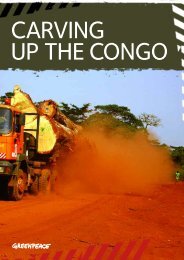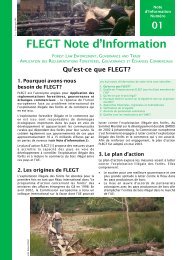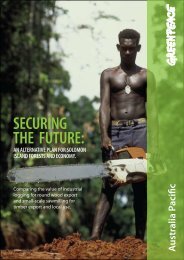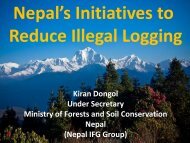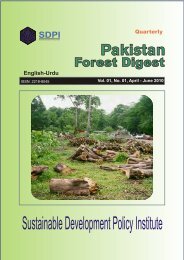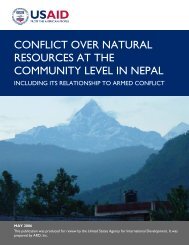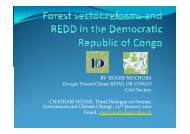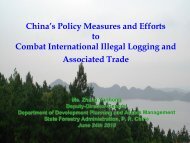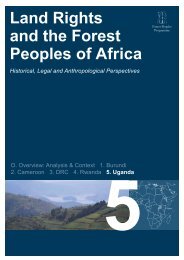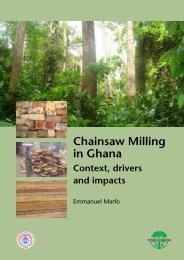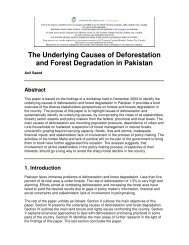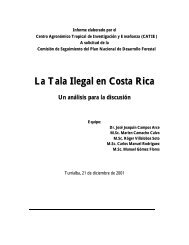CLEAR-CUT EXPLOITATION - Environmental Investigation Agency
CLEAR-CUT EXPLOITATION - Environmental Investigation Agency
CLEAR-CUT EXPLOITATION - Environmental Investigation Agency
Create successful ePaper yourself
Turn your PDF publications into a flip-book with our unique Google optimized e-Paper software.
<strong>EXPLOITATION</strong> OF INDIGENOUS<br />
MOI TRIBE LANDOWNERS<br />
© EIA<br />
In an April 2009 investigation into the<br />
impacts of plantations expansion on the<br />
environment and indigenous peoples of<br />
Papua and West Papua provinces, EIA<br />
and Telapak interviewed Moi landowners<br />
in Sorong, West Papua province, who<br />
had released land to two oil palm<br />
plantation companies - PT Henrison<br />
Inti Persada (PT HIP) and PT Inti<br />
Kebun Sejahtera (PT IKS). 1<br />
Both plantations were set up by the<br />
Sutanto family, owners of the Kayu<br />
Lapis Indonesia Group (KLI).<br />
The 2009 fieldwork documented<br />
testimony of exploitative practices by<br />
PT HIP and PT IKS during land<br />
acquisition. Highly one-sided negotiations<br />
were characterised by persuasion and<br />
pressure from company staff backed by<br />
local government officials and, at times,<br />
intimidation from military and police.<br />
Landowners unanimously reported they<br />
had initially agreed to release large<br />
areas following up-front cash offers, but<br />
also largely due to company promises of<br />
benefits such as new houses, vehicles,<br />
and free education for their children.<br />
In 2011, EIA/Telapak returned to Sorong,<br />
hearing of continued dissatisfaction,<br />
uncovering new evidence of shockingly<br />
low land compensation agreements and<br />
documenting significant new forest<br />
clearance and other problems.<br />
EIA/Telapak also informed landowners<br />
of the new corporate and sovereign<br />
wealth fund owners of their land, and<br />
the huge profits these external actors<br />
will likely make.<br />
60 CENTS (PER HECTARE)<br />
In 2009, EIA/Telapak heard that no<br />
landowners had been able to retain<br />
copies of land rental ‘contracts’ signed<br />
with PT HIP or PT IKS. However, in<br />
2011 investigators acquired one such<br />
contract, exposing the true extent of<br />
exploitation by PT HIP.<br />
The ‘contract‘ - hastily hand-scrawled on<br />
notepad paper - is signed by PT HIP<br />
General Manager Agnes Winaryati and<br />
thumbprint-signed by the head of the<br />
Gilik clan. It states: “on October 13th<br />
2006, it was agreed to release indigenous /<br />
customary land of the Gilik Clan covering<br />
1,420 hectares with a yield [return] of Rp.<br />
8,500,000 (eight million five hundred<br />
thousand rupiah) and money for betel nut<br />
for an indigenous ceremony equalling Rp.<br />
4,000,000 (four million rupiah)”.<br />
The document evidences how,<br />
discounting the Rp.4 million (US$ 434)<br />
for a tribal ceremony, the Gilik clan<br />
of Malalis village received a one-off<br />
payment of US$923 (Rp. 8,500,000) for<br />
14.2 square kilometers of forest lands –<br />
equivalent to just US$65 per square<br />
kilometer, or US$0.65 per hectare.<br />
While the “release” period is not<br />
stipulated, the company will hold its<br />
official permit for 25-35 years, with a<br />
guaranteed extension if it chooses.<br />
TOP:<br />
Uprooted: Manu Gisim surveys<br />
the devastation on his land.<br />
ABOVE:<br />
A 2006 land rental “contract”<br />
details compensation of merely<br />
US$0.65 per hectare.<br />
“The Gilik clan<br />
received merely<br />
US$923 for 14.2<br />
square kilometers<br />
of forest lands -<br />
US$0.65 per<br />
hectare”<br />
© PT Triton Papua<br />
2




